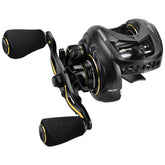
A Bass Fishing Guide to Flipping, Pitching, and Punching
How often when bass fishing do use one of these techniques: Flippin', Punchin' and Pitchin'? These three methods, all of which will enable a bass angler to get to fish sometimes unobtainable by other methods. They are all similar, but believe it or not, all three are different. For the most part when I bass fish, I am flipping, however, there are times when I change to pitching and punching depending on cover and conditions. My goal when fishing for bass is to catch fish, so I will use every method and technique I know to score. If I am fishing cover, all three of these options will come into play at one time or another. Before you can determine what one to use, you really have to understand what they are meant to achieve. Once you understand the three, your options when fishing heavy cover were just expanded to three solid ways to catch bass!
What is the Flipping?
Flipping by definition is achieved by using a long rod to reach into cover, often in low-visibility water. The best areas, again by definition, are flooded bushes, grass beds, and undercut banks. I first started flipping into tall cat tails in New York where I would flip the jig high in the area over the tails and into holes. I caught a lot of big bass this way.
Flipping a jig into tight cover will result in a surprised bass, and a definite hook-up.
This is by far the technique I use more than any other. Flipping a jig or creature bait into deep pockets, lay downs or other structure at times will need pin-point accuracy. Flipping is made possible by using the either the new KastKing Spirale, 7-foot, 8-inch rod or the Speed Demon Pro 7-foot, 5-inch Flippin' rod. Remember, like I have said in past articles, the name of the rod is for guidance, and does not mean it does not have other applications.
KastKing Flipping Fishing Combo Learn More >>
What is the Pitching?
Pitching is similar to flipping except you almost never engage the reel until you hook a fish. Pitching involves using pendulum casts to quickly cover holes in close proximity to one another. With any of the longer KastKing rods, you can the lure slightly farther away from the boat than standard flipping. And, by using the pendulum method, you can cover a lot of options.
Pitching is a great way to cover a lot of ground while fishing a lily pad field. You can stay in one place and hit a lot of different holes in the pads. 
This is a technique I will use primarily when I am dissecting a large lily pad field. In New York, and a lot of other lakes throughout the US, lily pad fields offer a bass deadly cover to hide from the days' sun, seek baitfish out, and crush any panfish or crayfish crawling along the bottom with ease.
What is the Punching?
Punching involves using a heavier weight to break through the cover, such as vegetation or floating debris. A key to punching is holding the rod tip slightly higher than the other two methods. This will aid in the lure coming straight down, preferable through very thick cover.
When the cover is heavy, punching through the mats with heavy weights will put your bait in the strike zone. 
What is the difference between Flipping, Pitching and Punching?
To me, flipping and pitching are more of a finesse style of heavy cover fishing. For the most part, your tackle will be jigs to 1/2 ounce and maybe weights for creature baits up to 5/8 of an ounce. Both of these methods will be covering areas that have "holes" or "breaks" in the cover to enable you to get your lure to the strike zone. Similar to flipping or pitching, but used in very thick cover. For punching, the KastKing Speed Demon Punching rod, Assegai Punch Out or the Spirale 7-foot, 8-inch model. What I like about all three of these rods is the length. These rods allow me to keep the rod tip high as suggested, and drop the bait into cover. Bear in mind when you are punching, weights up to 2 ounces may be used to break through the cover. In fact, I was at a Bassmaster event several years ago and Chris Lane actually lofted the bait straight up from the boat, then when the lure reached its apex, he pulled hard straight down on the rod tip to add speed on the decent to get through a matted field. It worked, he broke the cover and had several good size bass.
How to choose between Flipping, Punching and Pitching?
If you love bass fishing, and you have not got into the heavy cover game yet, now is the time. Summer is here and that means the vegetation is at its highest in most regions. The water temperatures have risen to downright hot, and bass are looking for shelter anywhere they can find it. The best place for shelter will be under matted vegetation, overgrown vegetation hanging off embankments, lily pad fields and anything else that will shelter the bass from the sun, and cool the water down, even if it is means only 1 to 2 degrees.
Grab some KastKing gear and learn at least one of these techniques, then learn the remaining two and I guarantee your bass fishing in heavy cover will something you love, not dread on those hot summer days.
More About Bass Fishing:
Best Bass Fishing Rod for the Money - Assegai Fishing Rods
Choosing the Right Type of Braided Fishing Line for Bass Fishing












